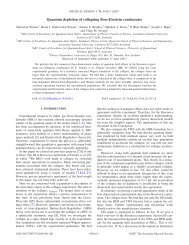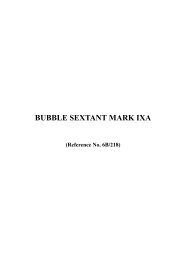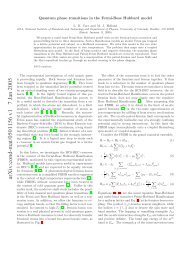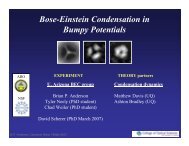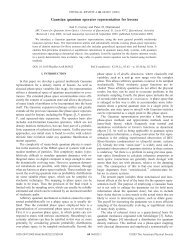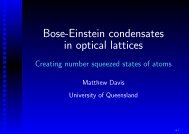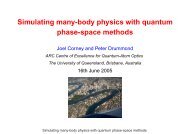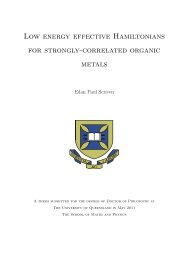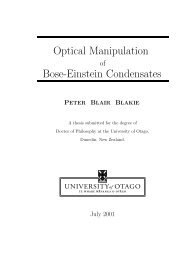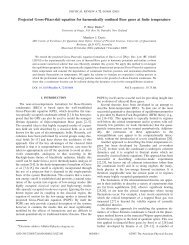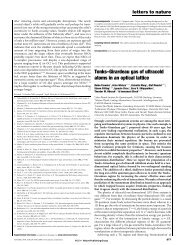Open Quantum Dynamics of Mesoscopic Bose-Einstein ... - Physics
Open Quantum Dynamics of Mesoscopic Bose-Einstein ... - Physics
Open Quantum Dynamics of Mesoscopic Bose-Einstein ... - Physics
You also want an ePaper? Increase the reach of your titles
YUMPU automatically turns print PDFs into web optimized ePapers that Google loves.
2. Properties <strong>of</strong> an atomic <strong>Bose</strong> condensate in a double-well potentialThus the dynamics are no longer constrained to the Bloch sphere, due to the diffusivespread <strong>of</strong> individual trajectories over the surface <strong>of</strong> the sphere. The tunnelling oscillationsin x and y will be damped at the rate 1 2 γ/N2 .The master equation for the mean operators (Eq. (2.85)) is not unique to the particularstochastic realisation we have used to derive it. In fact, we may also regard Eq. (2.85) asthe mean behaviour <strong>of</strong> a ‘jump’ stochastic process, which allows a simple calculation <strong>of</strong> themean-operator evolution. In this realisation, discrete ‘detection events’ (due to the Ĵx ˆρ e Ĵ xterm) are separated by periods <strong>of</strong> continuous evolution (due to the Ĵ x 2 ˆρ e +ˆρ e Ĵx 2 ). We theninterpret individual stochastic trajectories as the evolution conditioned on past detectionevents. For a pure initial state, the conditional master equation for this realisation leadsthe stochastic Schrödinger equation[179]:⎡ ⎛ ⎞d ∣ Ψc (t) 〉 = ⎣dN(t) ⎝√ Ĵx(〈Ĵ 〉 − 1 ⎠ γ( 〈Ĵ 〉 ) (2+ dt2 N 2 x c − Ĵ x2 − i ΩĴz +2κĴ x)) ⎤2 ⎦ ∣ Ψc (t) 〉 ,xwhere the random variable dN(t) ∈{0, 1} takes on the expectation value(2.87)E [dN(t)] = 2γ 〈Ĵ 〉2N 2 x dt. (2.88)cThis expectation value is the probability that a measurement event will occur in time dt,in which case dN =1. OtherwisedN = 0. This means that if a detection occurs, thesystem ket jumps to∣∣˜Ψ′ c (t) 〉 ∣= Ĵx∣Ψ c (t) 〉 , (2.89)where the tilde denotes an unnormalised ket. In between jumps, the system evolves nonunitarilyto∣∣˜Ψc (t +∆t) 〉 = e −iĤ′ t/ ∣ ∣ Ψc (t) 〉 , (2.90)where Ĥ′ = Ĥ2 − i 1 2 γ/N 2 Ĵ 2 x.Figure 2.19 shows the conditional and unconditional evolution <strong>of</strong> the <strong>of</strong> 〈 Ĵ x〉in theabsence <strong>of</strong> atomic collisions for two different values <strong>of</strong> γ. When γ = 10Ω (Fig. 2.19(a)),〈Ĵx〉executes full tunnelling oscillations, although at t = 100, the amplitude in the unconditionalevolution has decayed by 5%. This agrees with the semiclassical equations (Eq.55



